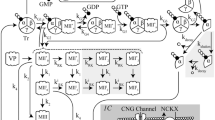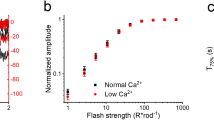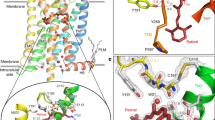Abstract
BLEACHING of rhodopsin markedly desensitizes the vertebrate visual system during a subsequent period of dark adaptation1–6. Previous studies have indicated an origin of bleaching desensitization in the visual pigment itself, but have not identified the mechanism of action. A candidate for the site at which densensitization is initially expressed is the activation of transducin (formation of T*) on the rod disk membranes; this reaction directly involves rhodopsin in its photoactivated (R*) form and mediates initial amplification of the visual signal (reviewed in refs 7–9). We have analysed the effect of bleaching on the sensitivity of a flash-induced light-scattering signal known to monitor the disk-based amplifier10–12, and which has been established as specifically monitoring transducin activation13. We have recorded this signal from functioning retinal rods in situ ('ATR' signal)14 and find that bleaches inducing a pronounced, sustained loss in rod electro-physiological sensitivity do not alter the sensitivity of the ATR response after correction for reduced quantum catch. Our results indicate that the biochemical gain of the R*→T* transduction stage remains unchanged in the presence of bleached pigment and implicate a subsequent reaction as the first to show a sustained, bleaching-dependent gain reduction.
This is a preview of subscription content, access via your institution
Access options
Subscribe to this journal
Receive 51 print issues and online access
$199.00 per year
only $3.90 per issue
Buy this article
- Purchase on Springer Link
- Instant access to full article PDF
Prices may be subject to local taxes which are calculated during checkout
Similar content being viewed by others
References
Dowling, J. E. Nature 188, 114–118 (1960).
Rushton, W. A. H. J. Physiol., Lond. 156, 193–205 (1961).
Rushton, W. A. H. J. Physiol., Lond. 181, 645–655 (1965).
Dowling, J. E. & Ripps, H. J. gen. Physiol. 56, 491–520 (1970).
Pepperberg, D. R., Brown, P. K., Lurie, M. & Dowling, J. E. J. gen. Physiol. 71, 369–396 (1978).
Bonds, A. B. & Enroth-Cugell, C. J. Physiol., Lond. 295, 47–68 (1979).
Kühn, H. in Progress in Retinal Research Vol. 3 (eds Osborne, N. N. & Chader, G. J.) 123–156 (Pergamon, Oxford, 1984).
Liebman, P. A., Parker, K. R. & Dratz, E. A. A. Rev. Physiol. 49, 765–791 (1987).
Chabre, M. & Deterre, P. Eur. J. Biochem. 179, 255–266 (1989).
Kühn, H., Bennett, N., Michel-Villaz, M. & Chabre, M. Proc. natn. Acad. Sci. U.S.A. 78, 6873–6877 (1981).
Vuong, T. M., Chabre, M. & Stryer, L. Nature 311, 659–661 (1984).
Kamps, K. M. P., Reichert, J. & Hofmann, K. P. FEBS Lett. 188, 15–20 (1985).
Bruckert, F., Vuong, T. M. & Chabre, M. Eur. Biophys. J. 16, 207–218 (1988).
Pepperberg, D. R., Kahlert, M., Krause, A. & Hofmann, K. P. Proc. natn. Acad. Sci. U.S.A. 85, 5531–5535 (1988).
Weinstein, G. W., Hobson, R. R. & Dowling, J. E. Nature 215, 134–138 (1967).
Ernst, W. & Kemp, C. M. Vision Res. 12, 1937–1946 (1972).
Grabowski, S. R. & Pak, W. L. J. Physiol., Lond. 247, 363–391 (1975).
Donner, K. O. & Hemilä, S. O. J. Physiol., Lond. 287, 93–106 (1979).
Baylor, D. A. & Lamb, T. D. J. Physiol., Lond. 328, 49–71 (1982).
Sillman, A. J., Ito, H. & Tomita, T. Vision Res. 9, 1435–1442 (1969).
Liebman, P. A. & Pugh, E. N. Jr Nature 287, 734–736 (1980).
Sitaramayya, A. & Liebman, P. A. J. biol. Chem. 258, 12106–12109 (1983).
Matthews, H. R., Murphy, R. L. W., Fain, G. L. & Lamb, T. D. Nature 334, 67–69 (1988).
Nakatani, K. & Yau, K.-W. Nature 334, 69–71 (1988).
Robinson, P. R., Radeke, M. J., Cote, R. H. & Bownds, M. D. J. biol. Chem. 261, 313–318 (1986).
Barkdoll, A. E., III, Pugh, E. N. Jr & Sitaramayya, A. J. gen. Physiol. 93, 1091–1108 (1989).
Pepperberg, D. R. & Clack, J. W. Vision Res. 24, 1481–1486 (1984).
Barlow, H. B. & Sparrock, J. M. B. Science 144, 1309–1314 (1964).
Lamb, T. D. Nature 287, 349–351 (1980).
Lamb, T. D., McNaughton, P. A. & Yau, K.-W. J. Physiol., Lond. 319, 463–496 (1981).
Baylor, D. A., Nunn, B. J. & Schnapf, J. L. J. Physiol., Lond. 357, 575–607 (1984).
Author information
Authors and Affiliations
Rights and permissions
About this article
Cite this article
Kahlert, M., Pepperberg, D. & Hofmann, K. Effect of bleached rhodopsin on signal amplification in rod visual receptors. Nature 345, 537–539 (1990). https://doi.org/10.1038/345537a0
Received:
Accepted:
Issue Date:
DOI: https://doi.org/10.1038/345537a0
Comments
By submitting a comment you agree to abide by our Terms and Community Guidelines. If you find something abusive or that does not comply with our terms or guidelines please flag it as inappropriate.



